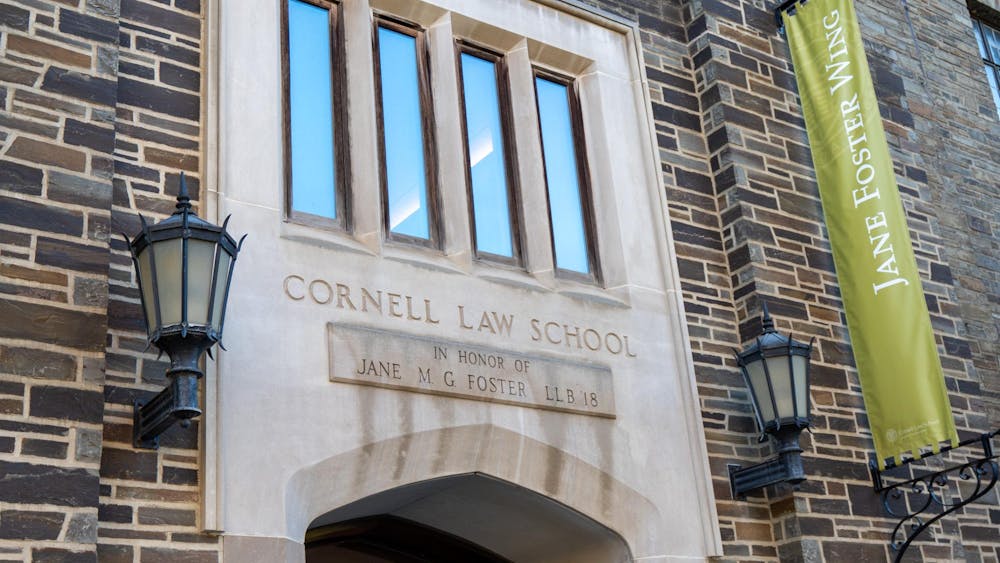On April 26, I rushed out of my last afternoon class and dashed in the direction of Triphammer Footbridge. In order to make it in time, I’d chosen to take my online class at the Martin Y. Tang Welcome Center, a building I had only ever briefly scouted to check if it had wi-fi. Virtually empty, I was saved by its abundance of comfortable seats, a charging port and personnel who were willing to suffer the disturbances of someone taking a class.
But I’d gotten something wrong! It must have been past 4:00 already, but aside from the usual passersby, nowhere was the crowd or orating professor I had expected. Again, I was saved — this time by a chance overhearing. Someone was directing two similarly-confused people towards the actual Triphammer bridge — the one I went over nearly every day! Shamefaced, I rushed back in the other direction.
Until I heard of tripartite campus event "Ammons & The Falls," starting with a walking tour to unveil new displays for two of his poems, I had been ignorant of Ammons’ status as a major poet. The only reference to him I had seen was on a poster in Goldwin Smith reading “Ammonites.” After a brief search for his name, it’d merely struck me as an endearing pun. Only when preparing to report on the first part of the event did I research more deeply into Ammons.
A. R. Ammons was born in North Carolina on Feb. 18, 1926 and taught at Cornell from 1964 to 1998. For his poetry, he won numerous awards, including the National Book Award. He passed away on Feb. 25, 2001, almost exactly a year before I was born. Eager to remedy my ignorance, I looked into more of his poems. My favorite so far is “Catalyst,” a panegyric to the humble maggot that employs internal rhymes, rollicking enjambment and richly visceral language of decay.
Back to April 26: when I arrived at the first unveiling on Triphammer Bridge, I found literatures in English Prof. Roger Gilbert already there along with a small crowd of onlookers. After introducing myself, I watched as Gilbert made some introductory remarks, thanked people for their contributions — and unveiled the display, previously obscured by a black plastic covering.
Located in an unobtrusive part of the bridge, near the end towards North Campus, the display featured a brief biography of Ammons himself framed by a photo of the falls in winter, while one of them in a warmer season provided a backdrop for the poem, “Triphammer Bridge,” which Gilbert read aloud.
Afterwards, I followed the group across campus towards Cascadilla. Along the way, I struck up a conversation with a local event-goer who went by Norm, who opined that more attention should be paid to poetry’s phonetic elements — the sounds of the words rather than only how people feel about them.
Meanwhile, the tour took us through Goldwin Smith Hall, where Gilbert showed us where Ammons’ former office had been located — and told us of a time when students decorated his office door with garbage after Ammons won the National Book Award for his collection of the same name. Once again, I was genuinely surprised — I must have walked down that hall hundreds of times, yet it never occurred to me that such a figure once had an office there.
Exiting Goldwin Smith, we passed by the small creek that ran near Sage Chapel and the Cornell Store. Apparently, Ammons had written about it as well — until this point, I’d had no idea it had a name, let alone that an award-winning poet had written about a creek named “Wee Stinky.” But so he’d written, and Gilbert read the poem humorously.
Not until the walk along Cascadilla Gorge Trail did I catch up to the professor once more. When asked if he’d known Ammons personally, Gilbert said yes, he’d known him from 1987 through 2001, when Ammons passed away. “Although, I was reading and admiring his work before that,” continued Gilbert. “In fact, I was writing about him in my dissertation before I came to Cornell. When I hadn’t yet decided to attempt the job, he called me up at home and I was just flabbergasted.”
Soon we had reached the second unveiling, close to the Schwartz Performing Arts Center. Here, there was a little mishap — apparently the display had become uncovered and Gilbert had to rush over to re-cover it. Someone also noticed a small typo “[i]” after a line in “Cascadilla Falls,” but otherwise, things proceeded smoothly.
My final question to Gilbert was on which of Ammons’ poems was his favorite. To this, he said, “If I could only choose one poem, I think I would choose one of the long poems … I might choose his long poem, Garbage.” He stressed how hard it was to choose, before naming the poem “Mechanism,” about the inner workings of a goldfinch, as another of his favorites. “This is what [Ammons is] really known for,” he concluded: “Mixing science and natural wonder together, allowing us to see how knowing the science behind things does not in any way diminish their beauty.”
As I left the unveiling, I felt humbled by this rendering of poetry from the scenery that had now become quotidian to me. When one settles into a pattern, it becomes easy to think of these places as mundane. I certainly don’t think constantly of all the people who have passed through Cornell through a century and a half, ordinary students or award-winning poets. I think even less of the names of creeks, or of the precise trajectories by which water crashes onto rock in every gorge.
But Ithaca, like other places, has its own history, stretching back not only through the twentieth century but billions of years into geological time. Perhaps we are all as Ammons’ goldfinch, “unconscious of the billion operations that stay its form,” the layers of our skin like mineral strata stretching far underground.
Amy Wang is a sophomore in the College of Arts and Sciences. She can be reached at amwang@cornellsun.com.











